
DATÜM: Blockchain in Architecture & Design
Blockchain technology has evolved from a protected digital ledger for the financial services industry to now being utilized by industries such as real estate and design. However, blockchain technology’s enormous potential on businesses and consumers has not been fully realized as this technology is still evolving. Designers are beginning to grasp how blockchain technology is impacting their work and driving conversations with clients, so that they can successfully guide clients through this period of rapid technological innovation. Because, when it comes to technology, the last one to adopt loses.
EVOLUTION OF BLOCKCHAIN
We are in a technological revolution with advancements occurring at an exponential rate, and companies are carefully balancing risk and reward. Invest too early in an immature technology and it could fail, arrive too late to the game and the competition could be miles ahead. Blockchain entered the tech world in 2008, about the same time that Airbnb was created. So, if you’re still wondering what blockchain technology is – don’t be alarmed, you’re not alone. Blockchain has had a slow adoption rate and only recently has begun to move beyond the volatile cryptocurrency market into more mainstream functions.
A survey by HSBC found that 59% of consumers polled said they’d never heard of blockchain technology; and 80% of consumers who’ve heard of blockchain don’t know what it does. To help catch you up, here’s a video that provides a simple explanation on how blockchain technology works. An easy way to think of it is a decentralized digital ledger that improves data transparency and transaction history.
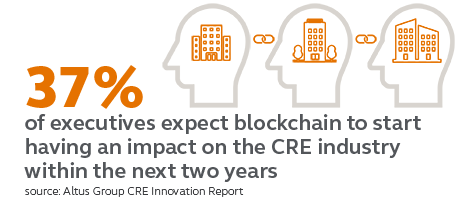
Although people have been slow to adopt blockchain, it’s thought to be a growing force in the world and across sectors. Is this the year it finally becomes ‘normal’? Consider the data:
-
- Growing Industry Interest: Nearly 10% of CRE executives “don’t really understand blockchain and what it does,” while 37% of executives expect blockchain to start having an impact on the CRE industry within the next two years [source: Altus Group CRE Innovation Report]
- Companies to Watch: IBM and Microsoft Corp. have grabbed 57% of the more than $700 million market for blockchain products and services [source: WinterGreen Research Inc.]
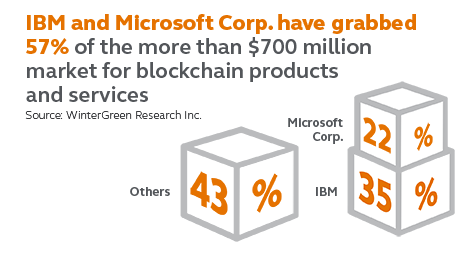
- Proof of Concept & Adoption: 90% of corporate blockchain experiments won’t make it into corporate use [source: Forrester Research Inc.]
- Strong Interest in Middle East & China:
-
- Dubai is aiming to become the first blockchain-powered city by 2020 [source: Smart Dubai]
- Over the past 5 years, interest in Blockchain as a Google search term has skyrocketed in China [source: Google Trends]
-
FROM CRYPTOCURRENCY TO SOCIAL CURRENCY
Here are a few recent examples of how various companies are utilizing blockchain technology to transform the design industry:
Fractional Ownership
There is a growing gap between rising house prices and stagnant incomes, making it harder for people to have money for a down payment or to secure a bank loan. A new ownership model is helping New Yorkers and Londoners to get on the housing ownership game. Multifamily residential buildings will no longer be defined as an apartment or condo, these concepts are blurring as access to ownership is democratized. In London, shared ownership is a type of affordable housing where you buy part of a home (between 25 and 75 percent) and pay rent on the rest, this model is aimed at first-time buyers who can’t afford to buy on the open market. Owners can then buy additional shares in the property over time. Property investment start-up Meridio turns any property type into “units” that represent a share of the building, which can be purchased by tenants and investors alike using blockchain technology ensuring the asset remains liquid and easily traceable. These models are allowing a portion of renter households to use their rent money to buy into a building or unit so that they can receive shares on their investment – and are opening up opportunities for other buildings types as well, such as office buildings and workplace tenants burdened by high real estate costs.
Increasing Speed to Street
Due to high regulations and an industry that has been behind innovation, the construction process can be slow. According to McKinsey research, construction productivity has been flat for decades, and lagging construction activity costs the global economy $1.6 trillion annually. McKinsey estimates that 98 percent of megaprojects suffer cost overruns of more than 30 percent; 77 percent are at least 40 percent late. Investors and developers are keen to deliver their project to more quickly see returns. We’ve seen major strides in VR, 3D printing and drone surveying in the construction and design process. However, blockchain is a way to speed up some of the delivery processes and save money by removing most of the intermediaries involved in contracts and payments. Any time a change is made, or a payment is due, it’s recorded into blocks that will forever be a part of the digital ledger that all stakeholders have access to. Say goodbye to lost emails and paper records.
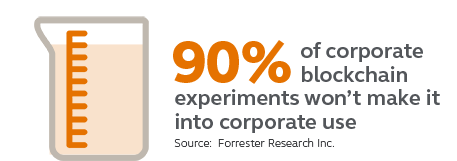
Operations: Eliminating Food Waste & Improving Consumer Safety
Food waste costs the hospitality sector more than $100 billion dollars every year. For every
$1 hotels invested in programs to reduce kitchen food waste, on average they saved $7 in operating costs. New technologies, like blockchain, are helping hotels, restaurants and grocery stores tackle food waste.
With a swelling world population particularly in urban areas, one third of food produced globally is wasted and yet families around the world are still living in hunger. Currently, we waste 1.6 billion tons of food annually, worth about $1.2 trillion dollars and food waste could rise by almost a third by 2030 when more than two billion tons will be discarded. One of the major challenges is a chaotic food distribution and supply chain, where 45 percent of fruits and vegetables go uneaten. IBM researchers are combining blockchain technology with Internet of Things (IoT) sensors and Artificial Intelligence (AI) algorithms, making seed-to-plate food tracking happen in real-time. So, for example, if oranges are flying off the shelf in Minnesota, a shipper in Florida would know about it immediately and send more. Farmers are given more precise data to only grow a certain amount of oranges per season – eliminating the pressure of agricultural subsidies to overproduce.
Last year, 76 million people in the U.S. got sick from foodborne illnesses, according to the Centers for Disease Control. Remember the romaine lettuce contamination last year in the US and Canada? With little information about the origins of the contamination consumers didn’t know if the romaine lettuce that they purchased was safe. As consumers demanding more information about where their food comes from, Walmart is working with IBM to implement blockchain technology with the aim to track food from farm to store in near real time using blockchain’s distributed ledger system. Walmart first tested its conventional way of tracing mangoes at the store back to their origin and it took nearly seven days. The same test was completed using blockchain technology and it took 2.2 seconds. Chinese insurance firm ZhongAn has been using blockchain-based systems to trace and monitor the life cycles of chickens to more accurately determine the origin and also treatment of the animals prior to consumer consumption.
Take a few minutes and watch IBM’s 5 in 5 predictions to see how blockchain technology is transforming the food and logistics sectors and prepare to have your mind blown.
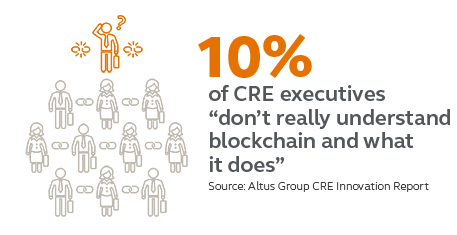
Healthcare Data: Balancing Protection & Access
As consumer awareness of the potential for early diagnoses of genetic diseases and more personalized consumer products continues to grow genetic testing, wearables and at-home kits are helping consumers by providing deeper knowledge about their health. This data is particularly of interest to healthcare providers and researchers looking to harness this knowledge to provide more personalized care to patients and tackle larger public health issues.
More than 115 people in the U.S. die every day after overdosing on opioids, according to the National Institute on Drug Abuse. The Institute sets the price tag for the economic burden for prescription opioid misuse in the U.S. at $78.5 billion a year. The Centers for Disease Control and IBM are collaborating on a blockchain-based system that could track public health issues like the ongoing opioid epidemic by making it easier for public health agencies to survey hospitals and physicians about their patients and prescription practices. Pharma industry giants including McKesson and Johnson & Johnson are working with Intel to develop ways to deploy blockchain to better trace how pills are distributed – including people who try to get multiple prescriptions from different doctors even across state lines or buy from online sellers.
In an effort to improve transparency and interoperability, IBM’s created a health utility network which includes Aetna, Anthem, Health Care Service Corporation, PNC Bank, Cigna and Sentara Healthcare. These organizations are exploring how blockchain technology can be used to address various industry challenges, including promoting efficient claims and payment processing to enabling secure and frictionless healthcare information exchanges. The potential for patient information to be shared across a decentralized, protected space has enormous benefits for patients. If you are travelling out of the country and have an emergency and are taken to a local hospital, your health records including medical history, current medications and allergies are unknown to the doctors treating you – that is, until blockchain. With blockchain technology, patients can give their consent to share health records with any healthcare provider so that healthcare professionals can quickly provide the best care.
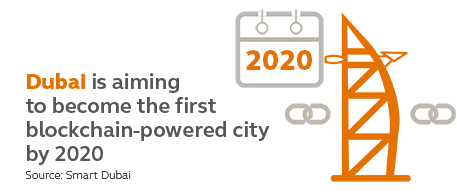
Digital Investment & Smart Cities
Dubai’s government recently announced plans to transform the citizen experience by implementing blockchain technology in civic services by partnering with IBM. Dubai has already been utilizing blockchain technology for land registries and reconciliation of government bank accounts. Smart Dubai has been leading efforts to encourage the use of blockchain, with a vision to eliminate 1 billion pieces of paper used for government transactions annually and to make the emirate a paperless government by 2021.
DESIGN THROUGH INVENTION
As blockchain technology evolves and further penetrates the design industry, it’s important for designers to adapt our thinking to fully realize the capabilities this new technology can have on our work and to use this technology for good. In the past, blockchain and cryptocurrencies have earned a bad reputation – globally, 44% of all Bitcoin transactions are associated with illegal activity. However, many of the examples above show how this technology can be used to improve the lives of communities around the world. I am curious, as new technologies are helping to increase our productivity, what will we do with all that extra time? My vote: revisit the 40-hour workweek or use one of the days for continued education.
What other ways have you seen blockchain technology impact the design industry? Please comment below.

I enjoyed your article and the links to external videos. I now have a better understanding of blockchain technology. Thanks!.